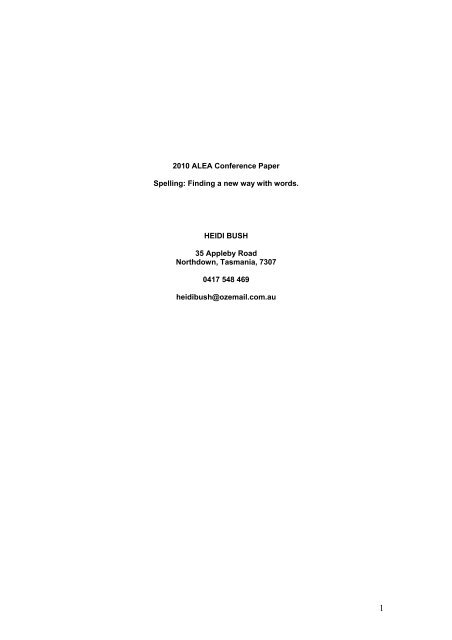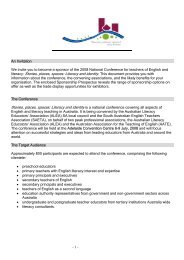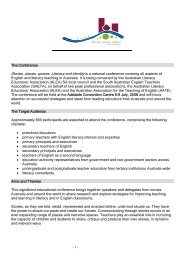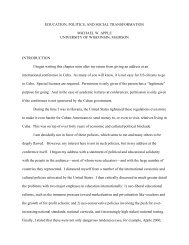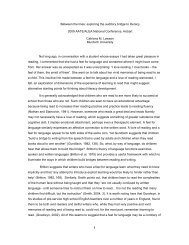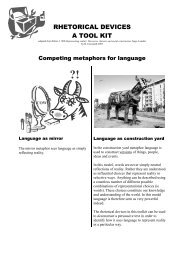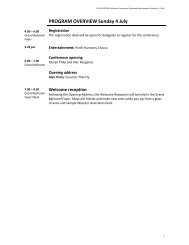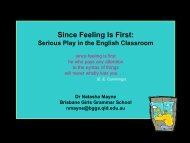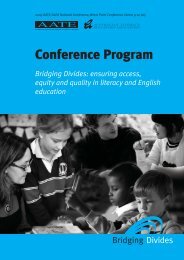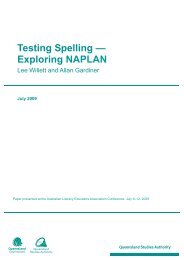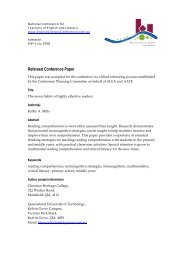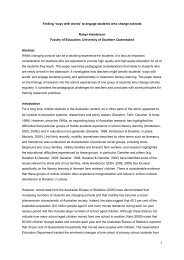Finding a new way with words. HEIDI BUSH 35 Appleby Road ...
Finding a new way with words. HEIDI BUSH 35 Appleby Road ...
Finding a new way with words. HEIDI BUSH 35 Appleby Road ...
Create successful ePaper yourself
Turn your PDF publications into a flip-book with our unique Google optimized e-Paper software.
2010 ALEA Conference PaperSpelling: <strong>Finding</strong> a <strong>new</strong> <strong>way</strong> <strong>with</strong> <strong>words</strong>.<strong>HEIDI</strong> <strong>BUSH</strong><strong>35</strong> <strong>Appleby</strong> <strong>Road</strong>Northdown, Tasmania, 73070417 548 469heidibush@ozemail.com.au1
Spelling: <strong>Finding</strong> a <strong>new</strong> <strong>way</strong> <strong>with</strong> <strong>words</strong>Spelling is an area that teachers often describe as problematic andinherently challenging to teach due to the nature of our language.Common approaches such as pre-set word lists, weekly tests and theuse of text books are often used as a means of managing the difficultiesof teaching this aspect of the curriculum and also as a perceived solutionto the challenges of working <strong>with</strong> a class of students <strong>with</strong> a vast range ofspelling abilities. This paper will outline an alternative approach toteaching spelling using a focus on inquiry, problem solving andinvestigation to enable students to learn and apply a range oftransferable strategies. This approach will focus on five key strategiesthat will assist students to not only spell successfully but enhanceengagement and interest in our language and its use. Approaches fordifferentiation will also be discussed <strong>with</strong> a focus on how key conceptsand questions about <strong>words</strong>, texts and spelling can be used as a strategicstimulus for teaching students across a range of levels.The Existing LandscapeThe field of education is one which has experienced significant and continual changeover many decades. Often described as the "swinging pendulum," approaches to teachingand learning have often varied widely resulting in either improved or reduced learning forstudents and some confusion or cynicism on the part of teachers as they are asked to adoptyet another <strong>new</strong> directive. It seems we are continually seeking some form of balancedcurriculum that delivers rich, effective and engaging experiences for students resulting indeep understanding rather than a superficial bank of memorised facts or procedures.Despite this rapid and continuous change, when we look closely at specific aspects ofour curriculum we can often see that very little change has occurred. The teaching of spellingfalls into this category, being an area that has often been taught in the same <strong>way</strong> for manyyears, regardless of the effectiveness of the approaches used. While subscribing to the beliefthat "if it isn't broken, don't fix it", many approaches to teaching spelling may be described as"it's broken but we don't know how to fix it" and consequently familiar approaches aremaintained in the absence of any known alternatives. When working <strong>with</strong> teachers to planlearning experiences or to provide professional learning, spelling is invariably a topic that israised, <strong>with</strong> many questions asked about how this may be improved. Comments such as, "Idon't like how my spelling program works but I'm not sure what else to do" or, "My studentsget good marks on their spelling tests but the same mistakes keep showing up in their writing"are common. These teachers are to be commended for reflecting on their practice andevaluating the effectiveness of this for their students. Before considering some alternativeapproaches to teaching spelling, let's consider some of the existing methods.ISL (Individual Spelling Lists)This is perhaps one of the more common approaches used in our primary schoolclassrooms and involves students working on a list of <strong>words</strong> that have been developed basedon their own spelling errors and <strong>words</strong> of interest. Students may be given a spelling test, oftenat the beginning of the week, <strong>with</strong> errors recorded in an individual list for each student. Thislist may be supplemented <strong>with</strong> <strong>words</strong> that have been incorrectly spelled in the student's2
writing and may also include topic <strong>words</strong> from a classroom focus. Students then take time,usually a week, to learn these <strong>words</strong> before being tested again at the end of the week, anyerrors recorded and the process beginning again. While this approach may be seen ascatering for different needs, as each student is working <strong>with</strong> a personal list of <strong>words</strong>, it isinherently problematic when we consider the teaching that accompanies the learning of these<strong>words</strong>. Students often learn the <strong>words</strong> in isolation of the teacher, as homework or by workingthrough various spelling activities related to their list <strong>words</strong>. These activities may includeputting each word in a sentence, counting the syllables in each word, finding dictionarymeanings and so on. While there is nothing wrong <strong>with</strong> such tasks per se, the problem lies instudents completing such tasks in the absence of explicit teaching. Consequently studentsspend time learning (or memorising) the <strong>words</strong> but not necessarily learning anything aboutthe <strong>words</strong> or how they are spelled and why they are spelled the <strong>way</strong> they are. Theseactivities are also completed for each individual word list and so students often do not learntransferable skills or knowledge. Rather than understanding strategies that can be applied tospelling a wide range of <strong>words</strong>, students focus on their list for the week, determined to learnthem ready for their test. This often results in the scenario of "they get it right on the test butspell it wrong in their writing." Students do not necessarily make the links between thespelling activities they are doing and how these relate to their writing. Recently I asked astudent what spelling meant for him and he replied, "That's ticks." Not understanding thisresponse, I asked him to explain. "Spelling is that book <strong>with</strong> the <strong>words</strong> down the side andticks in it," he said. He was describing his ISL book <strong>with</strong> his list of <strong>words</strong> and the ticks besideeach as he was tested on the <strong>words</strong> throughout the week. Here was a student for whomspelling was another separate thing to be done, <strong>with</strong> no understanding of how it relates towritten texts. We have to make the links explicit and we have to make the learningtransferable.Phonics ProgramsIt is critical that students receive explicit instruction in phonics as part of a balancedliteracy program and the ability to identify phonemes (letter sounds) and correspondinggraphemes (letters that represent these sounds) is an essential aspect of successful spelling.The inclusion of phonics instruction is important, however this often becomes the spellingprogram as a whole. Successful spelling requires knowledge and strategies beyond thephonological and phonics, rather than being the sole focus for spelling instruction, should bean essential component of a much broader spelling program that encompasses a range ofknowledge and strategies. As described in The National Inquiry into the Teaching of Literacy(Department of Education, Science and Training, 2005), no single approach will be effectivein isolation and attention to meaning, opportunities to apply knowledge and skills andindividualised strategies, along <strong>with</strong> a strong phonics focus, will prove more effective forliteracy acquisition.Text Books3
Text books and student work books are often used as a basis for teaching spelling,<strong>with</strong> students working through the word lists in the book and completing the related activities.Problems arise when a class of students are all working from the same text book, makingdifferentiation problematic and some students either working on tasks that are too easy or toochallenging. Students may also work through the activities <strong>with</strong>out true understanding beinggained. Students may complete activities successfully, yet the connection may not be seenbetween the activities being completed and the understanding and skills necessary fortransferable knowledge to be acquired. Research has also found there to be "… sufficientdevelopmental variation in any classroom to call into question the traditional use of spelling<strong>words</strong> drawn from a single corpus of grade level <strong>words</strong>." (Schlagal, 2002, p. 54).When teaching students the fundamentals of successful spelling we must strive forthe same rigour and principles of teaching and learning we apply to other curriculum areas.This includes teaching for understanding, teaching transferable knowledge, skills andconcepts, providing experiences that enable students to be actively engaged in their learningrather than passive receivers of information and encouraging students to problem solve,question and inquire.Teaching Spelling Through InquiryInquiry aimed at student understanding “… requires uncoverage of the material –inquiring into, around and underneath content instead of simply covering it” (Wiggins &McTighe, 1998, p. 98). This is precisely the experience we need to provide when teachingspelling. We want our students to inquire into our language, how <strong>words</strong> are constructed, theirorigins and patterns. We should encourage students to wonder about <strong>words</strong>, explore ourlanguage and be excited by discoveries. Such an approach does not ask students topassively fill in pages of workbooks or learn lists of <strong>words</strong>, rather it asks students to be activeand engaged learners, to pose questions and seek answers and ultimately apply and transfertheir <strong>new</strong> learning to multiple contexts. Research undertaken by Bloodgood and Pacifici(2004, p. 253) found that "… hands-on, engaging activities helped participants go beyondmemory to apply logic and critical thinking to spelling as well as to vocabulary and syntax."They found this resulted in heightened student interest in language and its use, expandedvocabularies and acquisition of effective strategies for making sense of how written languageworks. Similarly, Moats (2005, p. 22) suggests that spelling instruction need not simply be afocus on rules, but instead can be approached as an exploration of language, <strong>with</strong> knowledgethen applied in a range of written contexts. Wilson and Wing Jan (2003, p. 10) believe inquiryis "… based on the belief that students are powerful learners who must be actively engagedin investigating, processing, organising, synthesising, refining and extending theirknowledge... ". How often do our spelling programs require students to learn and performsuch skills and processes? If we were to think of teaching spelling through the lens of inquiry4
and expect students to discover, investigate, find, wonder, explain, analyse, compare,contrast, infer and generalise, what would our teaching and learning experiences look like?Explicit Teaching and Student InvestigationsThe missing link in the teaching of spelling is often the explicit instruction that enablesstudents to learn and understand key knowledge and strategies. The absence of explicitinstruction is often due to the structure of the classroom spelling program. For example, ifstudents are working on individual and quite different spelling lists, what is being taught inrelation to these twenty five of thirty different lists of <strong>words</strong>? Or there may be explicit teachingof one aspect of spelling, such as a focus on a particular phoneme, yet the students still workon their individual spelling lists, unrelated to the teaching focus. Such processes causeconfusion for students, management difficulties for teachers and an absence of purposefulteaching of spelling knowledge or strategies. A balance between explicit instruction andstudent driven inquiries and investigations is not a difficult marriage and should be the aim ofany classroom spelling program. This explicit teaching should occur in the form of word studylessons which enable students to analyse <strong>words</strong> and their spellings, as well as teachingspelling in context through reading and writing experiences.If students are to learn about <strong>words</strong>, rather than simply learn <strong>words</strong> from a list, sometime must be given to word study. Word study however, should not take the form of theteacher simply telling the students what they should know, <strong>with</strong> the students passive listeners.Rather, word study can become a process of discovery and investigation (Bush, 2008). Forexample the teacher may want the students to be familiar <strong>with</strong> the generalisation "When aword ends in a consonant + y, change the 'y' to an 'i' and add 'es' when making the wordplural". Rather than simply telling the students this "rule" followed by the students workingthrough a list of singular nouns which they then write as plurals as they apply the "rule", amore investigative approach may be used. For example the following lesson was undertaken<strong>with</strong> a class of grade three students focusing on the aforementioned generalisation.The teacher began by writing plural nouns ending in 'ies' on the board, such as cities,cherries and puppies <strong>with</strong> students given word cards <strong>with</strong> the corresponding singular nounending in 'y', (city, cherry, puppy and so on), which they then came forward and matched toeach plural. The question was then asked of the students, "Can anyone see what ishappening when the word becomes plural?" Students responded <strong>with</strong> observations such as,"The 'y' is gone" or "There's 'es' on the end of the plurals." As such suggestions were madean atmosphere of discovery was generated and a sense of excitement built as students madeimportant observations about the <strong>words</strong> and their spelling.As the discussion continued, the students decided that the generalisation they couldsee was, "When a word ends in 'y' change the 'y' to an 'i' and add 'es' when making the wordplural." This was written on the board at which point the teacher invited the students to testthe generalisation they had developed and included the <strong>words</strong> 'tray', 'boy' and 'key' on theboard. The question was asked, "Does our generalisation work for these <strong>words</strong> that end in5
'y'? Are there any changes we need to make to our generalisation?" The students agreed thatthe generalisation did not work for these <strong>words</strong>. Then one student said, "I looked at the letterbefore the 'y' and I can see that it's a consonant in the <strong>words</strong> that work for the generalisationand it’s a vowel for the exceptions." The generalisation was then modified to read, "When aword ends in a consonant and 'y', change the 'y' to an 'i' and add 'es' when making the wordplural."In such a process the students still learnt an important spelling generalisation or "rule"but did so in a far more meaningful <strong>way</strong>, as they came to the discovery themselves, ratherthan simply being told a "rule" to remember. They were also encouraged to become excitedand interested in <strong>words</strong>, through being involved in a dynamic lesson based on discovery andinvestigation. "Through small-group word study lessons we can explicitly teach students whatthey need to know about the English spelling system, and we can keep them engaged andmotivated through hands-on word work activities that promote inquiry and critical thinking."(Williams, Phillips-Birdsong, Hufnagel, Hungler & Lundstrom, 2009, pp. 577-578). Thisengagement is crucial as it has been found that students make more significant progress inspelling when teachers provoke their interest in <strong>words</strong> (Martins & Silva, 2006). Following thisperiod of explicit instruction, the students were given the task of investigating other <strong>words</strong> thatmatched the generalisation they had discovered and to look for exceptions. This resulted inthe students having lists of <strong>words</strong>, but rather than being lists of random <strong>words</strong> or pre-set listsfrom a book, they were lists of the students' own recorded findings and lists that had beengenerated directly from explicit teaching, making these <strong>words</strong> both meaningful and relevant.A similar process can be undertaken <strong>with</strong> other spelling foci, such as exploring howphonemes appear in <strong>words</strong> or investigating word origins or other generalisations. The criticalfeature is however, the important role of the teacher in beginning the inquiry, using explicitinstruction and purposeful questioning to enable students to explore ideas, analyse <strong>words</strong> andexplain observations before continuing to investigate further. Spelling investigations andinquiries in and of themselves do not make a successful speller. While task design isimportant, the teacher makes the difference, not the task.Time for explicit word study is critical, however spelling must also be taught in thecontext of a written text. Modelled writing provides an opportunity for the teacher to be the"expert" and model and vocalise their thinking and problem solving strategies whenattempting to spell <strong>words</strong> during the writing process. During shared writing, students canprovide input and suggestions regarding spelling or strategies and become involved in thedevelopment of the text, al<strong>way</strong>s being asked to explain the strategy they have used and whythis was an effective choice. Interactive writing enables students to become directly involvedin writing the text, while demonstrating and explaining their thinking when spelling. Similarlyshared and modelled reading provide opportunities for the teacher to guide students'observations of spelling and how <strong>words</strong> have been spelled or used in varying contexts,making critical links to spelling and meaning. This process provides three crucial pieces of thepuzzle that is successful spelling.6
1. Explicit instruction and word study <strong>with</strong>in a framework of active student participation,questioning and discovery <strong>with</strong> the teacher making important links in learning and supportingand enriching student understanding.2. Providing a context for spelling knowledge and understanding, making the importantconnection between spelling and a written text, so as to avoid the problem of students seeingspelling as an isolated activity. Through reading and writing students have the opportunity tosee their learning in the context of a text and use their learning as they develop their owntexts <strong>with</strong> the support and guidance of the teacher.3. Opportunities for self discovery, inquiry and investigation. As the teacher builds the interestin what the students have discovered during explicit lessons, students are then given theopportunity to explore further and report back on findings. Such a process not only givesownership to the learning, but makes it purposeful, meaningful and engaging.Five Key StrategiesTransferable knowledge cannot be achieved by learning lists of <strong>words</strong>; there aresimply too many <strong>words</strong> to learn! Teaching for transfer enables students to learn strategiesthey can apply to any number of <strong>words</strong>. A strategy approach, taught <strong>with</strong>in the framework ofexplicit instruction and inquiry, aims to develop in students the capacity to apply theirunderstanding and strategies across varied contexts and to enable them to choose the mosteffective strategy for a given context. Research conducted by Williams et al. (2009, p. 575)highlighted a need for explicit strategy instruction and recommended the integration ofstrategy instruction into word study lessons. In two of the projects undertaken in this researchthey found, "… strategy instruction was more salient for struggling students than otheraspects of word study instruction." (Williams et al.. 2009, p. 575). They also found that thesestrategies were transferred beyond the word study lesson and during writing tasks studentswere observed using the specific strategies that had been learned. The following five keystrategies can provide students <strong>with</strong> the knowledge and skills needed for successful spelling.Strategy One: HearingThis relates to phonological knowledge and the ability to hear, identify and representsounds in <strong>words</strong>. With this strategy, students learn such skills as breaking <strong>words</strong> intocomponent phonemes, representing these phonemes in different <strong>way</strong>s, breaking <strong>words</strong> intoparts and analysing these parts. The importance of phonics instruction is highlighted in thereport from the National Inquiry into the Teaching of Literacy (Department of Education,Science and Training, 2005) where it was found that for children to"… be able to link their knowledge of spoken language to their knowledgeof written language, they must first master the alphabetic code – thesystem of grapheme-phoneme correspondences that link written <strong>words</strong> totheir pronunciations." (p. 37).A teaching approach that includes a strong focus on developing phonological strategies instudents should be seen as an essential component of the overall approach to spellinginstruction.Strategy Two: Seeing7
Acquiring visual strategies enables students to learn how to recognise possible andimpossible letter sequences, how to recognise if a word looks incorrectly spelled, identify thepart of the word that looks incorrect and replace it <strong>with</strong> another possibility. This strategy alsorequires students to self monitor, self-correct and ask themselves questions to assist <strong>with</strong>spelling such as:Does it look right?Which part of the word doesn’t look right?What else could it be?What other letter /s can make that sound?Does any part of the word look like another word I know?Are there any little <strong>words</strong> in the word?Is it a compound word?Is there a root word?Look for visual patterns.A focus on visual strategies assists students to move beyond phonetic spelling. This is astage at which many students become "stuck" <strong>with</strong> common errors such as want/wont,what/wot and said/sed occurring. Teaching the strategy of Seeing, is to teach students how torecognise errors and to recognise common letter sequences and graphemes. For example,during modelled or shared writing experiences, the teacher may include incorrect spellingwhile attempting certain <strong>words</strong>, prompting students to identify and correct errors.Strategy Three: MeaningSuccessful spelling and meaning are inexorably linked and developing students'knowledge of morphemes, word origins and the importance of context when spelling <strong>words</strong> iscrucial. Seventy percent of the most commonly used <strong>words</strong> have multiple meanings and it isimportant for students struggling <strong>with</strong> literacy acquisition to understand this and learn theimportance of using context (Bromley, 2007, p. 531). During a recent interactive writingsession a group of students were constructing a text about their grandmothers and <strong>with</strong> theteacher, were writing about one student's grandmother <strong>with</strong> the text, "My nan hides in thepantry when her football team loses." The text had been jointly written <strong>with</strong> the involvement ofboth teacher and students and when writing the word 'loses', a discussion emerged over thecorrect spelling. Some students felt the word should be spelled 'loses' while others thought'losers' was correct. One student wrote these two <strong>words</strong> on the board for the group to see.The teacher explained that both these <strong>words</strong> were spelled correctly but only one was correctin the context of the sentence they were writing. The importance of meaning was discussedand the students explored the meaning of both <strong>words</strong> before deciding 'loses' was the correctchoice in this instance because as one student explained, "That's the 'loses' you use whenyou lose something, like the football game." This strategy also encourages students to selfmonitor and check for meaning, as accurate spelling is not al<strong>way</strong>s enough, as this scenarioshowed where two <strong>words</strong> were spelled correctly by the students yet, being homophones, themeaning of the <strong>words</strong> was the crucial factor in determining which was the correct word to use8
in the text. With a focus on meaning, students develop strategies and skills <strong>with</strong> theknowledge that some <strong>words</strong> can be spelled correctly but used incorrectly in a text because oftheir meaning and knowing the origin and meanings of <strong>words</strong> or parts of <strong>words</strong> can help makebetter spelling choices. The meanings of sixty percent of multisyllabic <strong>words</strong> can be inferredby analysing word parts and knowing the meaning of a root and affix often tells us what aword means (Bromley, 2007, p. 533). It is this focus on analysis that is important and studentsshould be provided <strong>with</strong> opportunities to engage <strong>with</strong> language and make discoveries aboutits use and purpose.Strategy Four: GeneralisingThis strategy involves applying spelling generalisations to spell a range of <strong>words</strong>. Asdescribed earlier, generalisations can be taught in a <strong>way</strong> that allows students to developthese themselves, rather than simple memorisation. Discovering generalisations andinvestigating matches and exceptions among <strong>words</strong> also promotes the atmosphere of inquiry,wonder and discovery that both engages and assists <strong>with</strong> the acquisition of knowledge.Strategy Five: LinkingAs <strong>with</strong> so much that we learn, spelling is about patterns and making links andconnections. Words are learned by associations that connect <strong>new</strong> information to existingknowledge and schema (Bromley, 2007, p. 531). This strategy focuses on linking the known<strong>with</strong> the unknown and assisting students to understand that there are things we can learnabout a small number of <strong>words</strong> that can help us spell many more and there are oftenconsistent parts of a word that we can use to spell <strong>new</strong> <strong>words</strong>. For example "word families"and onset and rime are commonly taught in our early years classrooms and this can be usedto make explicit links to spelling and spelling strategies. For example, if exploring the -atfamily of <strong>words</strong>, the teacher may ask, "How can we spell mat? How many sounds can wehear? What letters do we need to show those sounds? How have we spelled mat? If we knowhow to spell mat, I'm sure we know how to spell sat. How can we use what we know abouthow mat is spelled, to spell sat? If we can spell sat, can we also spell pat? What about pan?and so on. Rather than students simply adding letters to create their "word family" they arebeing deliberately asked to make links between known spelling and <strong>new</strong> spelling while alsoemploying phonological strategies to hear the different sounds in the <strong>words</strong> and visualstrategies to observe how the <strong>words</strong> look <strong>with</strong> the changed spelling. This strategy of Linking iscrucial as it is asking students to apply their knowledge to a <strong>new</strong> context by making vitalconnections between known and <strong>new</strong> spelling.Using Essential Questions for Transfer and DifferentiationIf we are to teach for true understanding and transfer, we need to get at the heart ofthe concept or knowledge we are wanting students to understand. Using Essential Questionswhen teaching spelling is a useful means of achieving this goal. An Essential Question is "…the essence of what you believe students should examine and know … The EssentialQuestion is just that: a question. The interrogative suggests investigation and inquiry …"9
Hayes Jacobs, (1997, p. 26). Essential Questions focus on essential understanding andtransferable concepts, while also promoting and guiding investigation and inquiry. Forexample, rather than simply asking students to put their list <strong>words</strong> in syllables, they mayinvestigate the Essential Question: How are syllables and vowel sounds connected? Thisrequires them to break <strong>words</strong> into syllables but goes further to make important links to howsyllables relate to spelling, an important transferable skill and strategy. Similarly, the EssentialQuestion: How can spelling affect meaning? asks students to explore the importance ofcontext and meaning to spelling and investigate important aspects of spelling and word usagesuch as homophones and homonyms. The use of these questions helps to ground thelearning in deeper understanding rather than superficial memorisation or acquisition of factsor rules. They also promote inquiry, so students arrive at crucial knowledge andunderstanding, <strong>with</strong>in a structure of purposeful questioning, guidance and instruction from theteacher.Essential Questions also provide a means of effectively differentiating instruction forstudents. This is often something teachers struggle <strong>with</strong>. "How can I teach different spellingskills when I have such a wide range of spelling ability in my classroom?" Carole AnnTomlinson (2001) suggests some overarching guidelines for differentiation that may beapplied to the teaching of spelling such as, being clear on the key concepts and principlesthat give meaning and structure to the lesson, lessons for all students should emphasisecritical and creative thinking, lessons should be engaging for all students and there should bea balance between student-selected and teacher assigned tasks. Using Essential Questionsduring a spelling lesson can honour these guidelines and make differentiation a manageablereality. Focusing on a question can enable all students to engage in the same discussion froma similar investigation or inquiry, but at their level of understanding. For example focusing ona particular phoneme for investigation such as the /k/ phoneme and beginning <strong>with</strong> theEssential Question "How can sounds in <strong>words</strong> be spelled in different <strong>way</strong>s?” allows somestudents to focus on two simple graphs (c, k), while others may explore beyond this (c, k, ch,ck, q, che). After initial teacher directed instruction, students are able to investigate thisquestion at different levels of complexity, while still being able to share their discoveries aboutthe shared Essential Question that has guiding the learning. With the teacher asking, "Whathave we discovered about this phoneme? those students who have worked <strong>with</strong> a smallernumber of <strong>words</strong> and <strong>with</strong> fewer graphemes are still able to report back on their discoveriesand be actively engaged in the discussion and lesson as a whole.It's Up To The TeacherTeaching <strong>with</strong> an inquiry approach places the learning <strong>with</strong> the student and promotesrich and deep understanding. It develops a sense of wonder, questioning and discovery whilemaintaining rigour and purpose in the teaching and learning. When we teach spelling it can beabout repetition, passive learners, worksheets, memorising <strong>words</strong> and completing tests … Or10
it can be about inquiring, problem solving, investigating, discovering, interactive learning,discussing and questioning. It's up to the teacher. We need to be curious ourselves aboutlanguage and how it works and strive to not only learn more about our language but continueto learn about <strong>new</strong> and engaging <strong>way</strong>s of assisting our students to learn. It pays to rememberthat if the learning is interesting, our students will be interested, if we are inquiring, ourstudents will discover and if we are questioning our students will wonder.11
REFERENCESBromley, K. (2007). Nine things every teacher should know about <strong>words</strong> and vocabularyinstruction. Journal of Adolescent & Adult Literacy, 50(7), April 2007, 528-537.Bloodgood, J. & Pacifici, L. (2004). Bringing word study to intermediate classrooms. TheReading Teacher, 58(3), November 2004, 250-263.Bush, H. (2008). The classroom spelling program: More than learning <strong>words</strong>. PracticallyPrimary, 13(2), 26-28.Department of Education, Science and Training. (2005). Teaching reading report andrecommendations: National inquiry into the teaching of literacy. Commonwealth ofAustralia.Hayes Jacobs, H. (1997). Mapping the Big Picture. Alexandria, Virginia: ASCD.Martins, M. A., & Silva, C. (2006). The impact of invented spelling on phonemic awareness.Learning and Instruction, 16, 41-56.Moats, L. (2005/06). How spelling supports reading. American Educator, Winter 2005/06, 12-43.Rees, D., Kovalevs, K. & Dewsbury, A. (1997). Spelling Resource Book. Port Melbourne:Rigby.Schlagal, B. (2002). Classroom spelling instruction: History, research, and practice. ReadingResearch and Instruction, 42(1), Fall 2002, 44-57.Tomlinson, C. (2001). How to differentiate instruction in mixed-ability classrooms (2nd ed.).Alexandria, Virginia: ASCD.Wiggins, G., & McTighe, J. (1998). Understanding by design. Columbus, OH: Merrill PrenticeHall.Williams, C., Phillips-Birdson, C., Hufnagel, K., Hungler, D. & Lundstrom, R. (2009). Wordstudy instruction in the K-2 classroom. The Reading Teacher, 62(7), April 2009, 570-578.Wilson, J. and Wing Jan L. (2003). Focus on Inquiry: A practical approach to integratedcurriculum planning. Carleton South, Victoria: Curriculum Corporation.12


